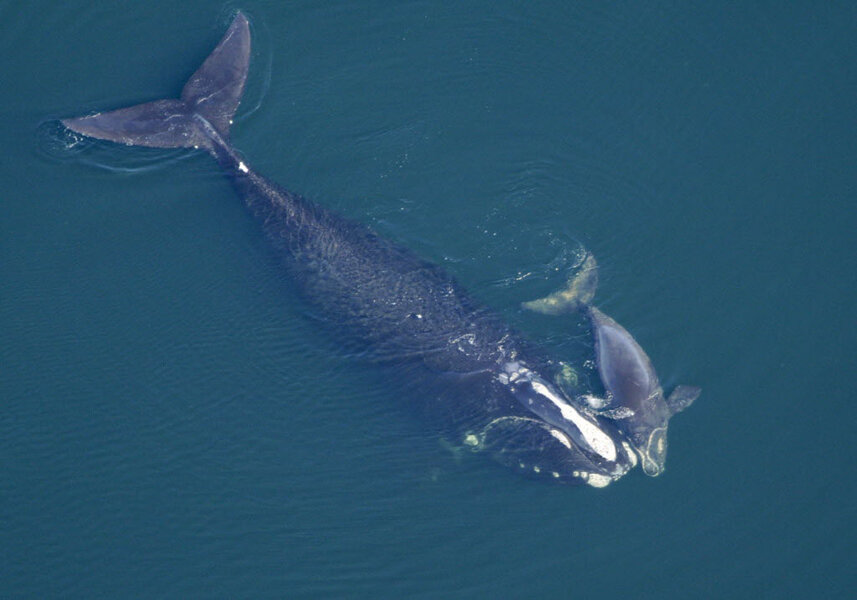How a better rope could help save the endangered right whale
Loading...
Life along North America’s East Coast hasn’t been kind to the North Atlantic right whale.
Whalers picked off thousands of them between the 17th and 20th centuries. Today, only about 500 remain, and they’re listed as “endangered” on the International Union for the Conservation of Nature’s “red list.”
Their numbers have edged up from about 350 just a few years ago, but researchers announced last week that this progress was at risk. Only three newborn calves have been sighted this winter – the fewest since 2000. Whale births do fluctuate from year to year, and another sighting off Cape Cod soon brought the total to four. But that’s still well below the yearly average of 17 – and hardly enough to offset annual deaths.
In a phone interview with The Christian Science Monitor, Regina Asmutis-Silvia, executive director of Whale and Dolphin Conservation North America (WDC), lists multiple threats – from ship noise to climate change – that North Atlantic right whales face today. But she and other experts describe one as particularly worrisome: the fishing nets and traps bobbing along the Eastern Seaboard, tethered by ropes that can snare the whales.
Scott Kraus, senior science advisor at the New England Aquarium’s (NEAQ's) Anderson-Cabot Center for Ocean Life, says tangled whales can drown, suffer fatal cuts, or endure “sub-lethal effects:” injuries that leave them less able to feed or reproduce. Dr. Asmutis-Silvia says “probably the biggest threat that they're facing right now is fishing gear entanglements.”
The recent rise in whale entanglements – from just two in the 1990s to 11 between 2010 and 2016 – has come as fishermen started using stronger ropes closer to shore. To solve this problem, they're now working with researchers and conservationists to re-design this age-old piece of equipment.
Speaking with the NEAQ's Amy Knowlton, Massachusetts lobsterman Mike Lane learned that whale entanglements had begun rising about 20 years ago. “Right around the same time,” he remembers, “they started developing new ropes that were stronger and stronger,” – able to withstand thousands of pounds of stress – “and I said, ‘It does kind of coincide.’ ”
Recent developments gave Mr. Lane and his fellow members of the South Shore Lobster Fishermen's Association reason to seek a more whale-friendly rope.
In 2013, a coalition of conservation groups sued the National Marine Fisheries Service (NMFS), claiming that its lobster fishery management “violated the Endangered Species Act and Marine Mammal Protection Act by allowing unlawful entanglements of endangered whales.”
In its settlement, the NMFS agreed to close 2,965 square nautical miles of regional waters from Feb. 1 to April 30, when right whales were likely to be present.
This change didn’t sit well with lobstermen. While Mr. Lane describes whale entanglements as “horrific,” he adds “if our only option is to close the fishery down, that's not really a good solution.”
“We said, ‘We gotta do something, to see if we can get something back, get some time back, or even some small areas back.’” To this end, they began experimenting with easier-to-break rope designs.
The NEAQ, with funding from the state of Massachusetts, soon joined them. Testing determined that a right whale could break any rope rated to withstand 1,700 pounds or less. The NEAQ's Dr. Kraus says that a 1700-pound-breakable rope “would probably be effective, and it would probably save whales' lives.”
The tests also found that most near-shore fishing gear could be supported by ropes well below that threshold. The fishermen interspaced the much stronger ropes they already had with strands designed to break at 1,700 pounds. “I've had good luck testing them, and all the guys we've had testing them on the South Shore, there haven't been any complaints,” Lane tells the Monitor.
The only problem, he says, is that “these things are quite labor-intensive to make.... We're hoping that there would be a company that makes a rope that just breaks at 1,700 pounds, that you could just buy off the shelves.”
A mass-produced breakaway rope could help lobstermen and whales coexist in many areas. Dr. Asmutis-Silvia of the WDC voiced concern about the imminent re-opening of the Cape Cod Bay lobster fishery, where 112 right whales had recently been sighted. “A lot of gear is going to go in the water where these whales are feeding,” she said. “That's a tremendous risk.”
Even if new ropes reduce these risks near Cape Cod, other fisheries will likely need a different solution. Lane says he only goes out about 20 miles in the winter, but others can go as far as 100 miles to reach their gear.
“This definitely won't work for them,” he says, explaining that deeper waters demand stronger ropes.
Kraus agrees that offshore fisheries still pose a challenge, and posits that the technology used to secure oceanographic research buoys could be adapted to fishermen’s needs.
Solving the problem may also demand closer tracking. “The data that's available is really difficult for us to use as managers,” explains Dave Gouveia, branch chief for the protected-species monitoring program at the National Oceanic and Atmospheric Administration's Greater Atlantic Regional Office. With the vast majority of entanglements, “you really don't have any indication of what specific fishery, or location, or even country of origin that the entanglement occurred.”
But as researchers work to solve these larger problems Lane calls their improvement on the humble rope “a step in the right direction,” adding that "It's the only thing I've seen ... in the last 20 years that's actually got some hope.”
[Editor's note: The description of the rope testing has been revised for clarity]






